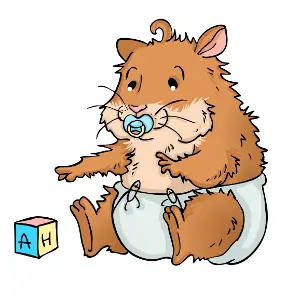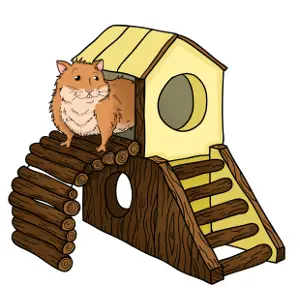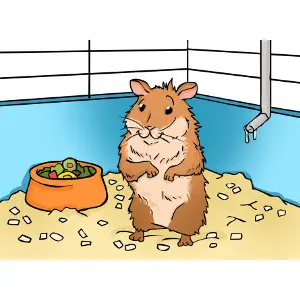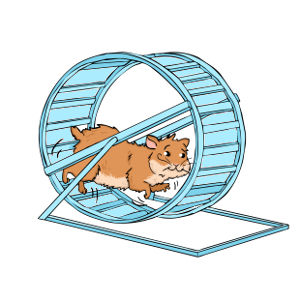An essential introduction to hamster care
Hamsters can seem like a cute and cuddly option when you are looking for the perfect pet, but how much do you actually know about hamster care, and how should you prepare to welcome a hamster into your home?

In this guide to hamster care, we give you the essential info you need to get started as a hamster owner!
1. Choosing the right type of hamster for you
The most common type of hamster that people have as a pet is the Syrian hamster, which is also often referred to as the Golden hamster. This little rodent originally comes from the northern regions of Syria, and the south of Turkey. It is considered to be vulnerable as a wild species as its habitat is under threat from destruction by humans. There is no such threat to Syrian hamsters in captivity.
Another popular type of pet hamster is the dwarf hamster. There are three types of dwarf hamsters that are related, and that you will normally see in pet stores, the Roborovski, and the two types of Russian dwarf hamster, Winter White and Campbell’s. The fourth type of dwarf hamster is the Chinese; this is not related to the other types of dwarf hamster.
Much like people, different hamsters are suited to different situations and homes. So the first decision you need to make is what type of hamster you want, and which is best suited to you and your circumstances.
Syrian hamsters

The first thing to remember about Syrian hamsters is that they should always be kept by themselves; they are very territorial and will fight with other hamsters.
Syrian hamsters are the largest of the captive hamster breeds and they are often the most popular as pets. They have a lively personality and can be really fun to watch and interact with. If you handle them from an early age Syrian hamsters can be trained well, if you have a little patience. They are generally slower paced than dwarf hamsters so they are easier to keep up with, especially during the training process.
The average lifespan for a Syrian hamster is 2 to 2.5 years, although like most animals, there are some individuals who live longer than this.
As an adult the average size of a Syrian hamster is 5.5 inches. Syrian hamsters are popular with novice hamster owners, and younger children, as they tend to be easier to handle and tame.
Dwarf hamsters
Dwarf hamsters are, as the name suggests, smaller than Syrian hamsters. They can normally be kept in a cage with other dwarf hamsters but you still need to check for any signs of upset or aggression, at which point they may need to be separated.
The Roborovski dwarf hamster is the smallest of the dwarf hamsters, and doesn’t grow much more than 3 inches in length, even as an adult. Roborovski dwarf hamsters are very fast and active; they have often been known to run as far as 100 miles per night on their hamster wheel. These adorable little creatures live for an average of 3 to 3.5 years.
Russian dwarf, Winter White hamsters get their name from their ability to turn white in the winter months in their wild Russian habitat. In captivity they normally retain their dark grey colouring due to the presence of artificial heat and lighting. As well as dark grey you can also see Winter White dwarf hamsters with other colouring, such as marbled, sapphire, pearl and sapphire pearl. These cute little rodents have an average captive lifespan of between 1.5 and 2 years.
Campbell’s dwarf hamsters are the dwarf hamsters that are most often found in pet stores. In the wild they are found in China, Russia and in other areas of Central Asia. Their dark grey appearance is very similar to that of the Winter White, and they have a similar lifespan; averaging around 2 years.
Chinese dwarf hamsters are actually more correctly named simply Chinese hamsters, but they are often mistaken for a dwarf hamster because of their small stature and the dorsal stripe that they have in common with Winter White and Campbell’s dwarf hamsters. They have an average lifespan of 1.5 and 2 years.
Find out more about the average hamster life span.
It’s also possible to buy hybrid dwarf hamsters which are a cross between Winter White and Campbell’s. This cross breeding is normally done to produce attractive colouring and is controversial, as hybrid dwarf hamsters have a tendency to develop health problems. For this reason it is best to avoid buying these tiny creatures.
Of the dwarf hamster varieties, Winter Whites and Campbell’s generally make the best pets as they are easier to train.
2. Buying a hamster: 6 top tips!

Once you know which type of hamster you want there are some things that you need to consider when you go to the store to choose your new pet.
1. Try to go later in the day
Hamsters are livelier in the evening than they are during the day. This is when you are most likely to see the real personality of a hamster. If you go to a pet store too early in the day it’s likely that the hamsters will be sleeping. You aren’t going to be able to tell if the one you are looking at is just acting as normal for a hamster, or is generally a little lazier than most.
2. Ask to take a closer look
If you ask the pet store owner to show you a hamster close up this will do two things. It will show you how the hamster reacts to being handled, and it will enable you to see if your future pet looks healthy. You should never buy a hamster that has a wet tail, bald spots or lumps (except for the scent glands on their legs). You should also make sure that the hamster you buy has clean ears and a clean, dry bottom. Obviously there is always the chance that your pet will become ill at some point after you take them home but you at least want to make sure they are healthy when they leave the store.
3. Watch the way the hamster acts
When the store owner handles the hamster you are hoping to buy then you will be able to check out its temperament. Ideally you want to choose a hamster that is lively and inquisitive, and appears to be friendly. You don’t really want to buy a hamster that is very nervous, and you definitely don’t want a pet that’s aggressive!
4. Have a look at the environment
A great deal of a hamster’s health and condition can depend on the environment in which it is kept. It’s not usually a good idea to buy a hamster that has been kept in cramped, dirty or damp conditions.
5. Ask about the age of the hamster
From the age of about 8 weeks female hamsters can be pregnant so you need to try and establish the age and sex of the hamster you are looking to buy. Hamsters are best purchased at the age of 4-6 weeks as they are easier to tame if you handle them from about that age.
6. Never be afraid to ask questions
Most pet store owners will be happy to provide as much information as they can about a hamster, so don’t be afraid to ask anything you want to know. If you just stand there and accept the first hamster you are offered then you are unlikely to get the pet you really want.
What happens when you bring a hamster home?
You’ve chosen a hamster and bought a cage, as well as accessories – such as a wheel – toys and food, but what happens when you actually arrive home with your new pet?
Like any animal, and most humans too, a hamster needs time to settle into their new environment. You should put your new hamster in their cage with enough food and water, bedding and a place for them to hide away, and leave them totally alone for 24 hours. This gives your pet time to relax and get used to being in their new home.
3. Your hamster’s home
Don’t forget that you can’t buy a hamster without also buying a suitable home for your new furry friend to live in.
If you decide that you prefer a Syrian hamster then you are, of course, going to have to buy a larger cage than you would for a dwarf hamster. But there are other factors to consider too; you need to give a great deal of thought to exactly what type of home is best for the new addition to your family.
The importance of cage size

Hamsters need to have plenty of space to run around; and that doesn’t mean a lot of pipes, it means actual floor space.
According to the National Hamster Council, a Syrian hamster should ideally have a cage that has floor space of at least 1000cm2 and a height of 19cm.
A dwarf hamster should have at least 750cm2 of floor space and a cage height of 17cm.
You should always make sure that the floor of the cage has a covering of at least 4cm depth of suitable bedding as hamsters love to burrow.
It’s important to note that it’s not a good idea to buy cedar or pine shavings for your pet as some hamsters can develop an allergic reaction which causes problems with their breathing. Find out more about hamster bedding.
Which is best, wire or plastic?
Wire and plastic cages are both popular forms of housing for hamsters, and they both have their advantages and disadvantages.
This is an example of a wire cage and this is an example of a moulded plastic habitat.
If you opt for a wire cage then your new pet won’t be short of somewhere to climb; and this is something that hamsters love to do. One thing you need to make sure of is that the wires are never more than half a centimetre apart as it can be dangerous if they are any wider apart; a hamster can become inquisitive and get stuck, especially a dwarf hamster. You should also never buy a cage that has a wire bottom, as this is not good for a hamster’s feet.
If you decide on a wire cage, make sure to use layers inside, so that if your hamster is climbing along the top of the cage, they don’t have too far to fall if they lose their grip. This stops your pet from hurting themselves. It’s especially important to have regard to this when your hamster is a baby as they can get seriously hurt if they fall from a high level.
There are many plastic moulded hamster cages on the market today. These hamster homes are very easy to clean, and they offer protection to your little friend, if you have other pets in your home. Many of these cages have a small area of wire which can act as a climbing frame for your hamster. If you buy a cage that doesn’t have somewhere for you hamster to climb, you need to make sure that you provide a climbing frame in the cage for them so they are free to climb whenever they want to.
One very important thing to remember about a hamster cage is that it needs to be escape proof. You would be amazed at how adept these adorable looking creatures can be at making a bid for freedom!
Make sure that there are no gaps your pet can squeeze through, and always check that doors are completely secure. If they are in any way loose there is a good chance that your resourceful little hamster will be able to open them.
Why a modular system may not be a good idea
You’ve probably seen the brightly coloured hamster cages that consist of a collection of tubes joined together. It is not usually a good idea to house a hamster in one of these cages. There are several reasons for this. A hamster needs to have plenty of room to run around, and these cages don’t have that; running up and down tubes is not the same thing. It’s important for your pet to have plenty of floor space available.
It’s also easy for a hamster to get stuck in the tubes; especially if you have a Syrian hamster. Lastly, if your hamster is a little timid it may decide to hide out in the tubes and you’ll spend a lot of time having to dismantle the tubes, in order to reach your pet. This is not an appealing prospect.
The importance of toys
One very important thing that you need to remember, when you’re setting up a home for your hamster, is toys. Hamsters love to have something to keep them occupied; a wheel on its own isn’t enough.
As well as the usual hamster wheel you need to provide a selection of other toys, such as wooden chew toys. These toys are an excellent choice as they provide a fun activity for your hamster whilst, at the same time, stopping their teeth from becoming overgrown.
You need to make sure that you only give your pet wood that is safe, and not treated with pesticides. Cardboard is also a favourite with hamsters. You can get pet friendly cardboard rolls from retailers if you are concerned about the glue and ink which may be present in common household cardboard items.
One very important item in a hamster’s cage is somewhere for them to hide away; like a specially made hamster house. Your pet will want a place to escape to, especially for daytime sleeping, so you need to provide this for them. A word of warning, with any plastic items in your hamster’s cage you need to keep an eye on your pet’s interaction with the item. If your hamster starts to chew and swallow the plastic, this is bad for them.

Having a ball!
One of the main toys that a lot of people buy when they first get a hamster, is a hamster ball. Most people have probably seen the brightly coloured plastic orbs careering around someone’s floor, run only on hamster power.
Most hamsters will happily use a hamster ball, although you should never force your pet to do so if they seem reluctant. We’ll look at using a hamster ball in more detail when we consider the exercise your new hamster will need. Suffice to say that most of these cuddly rodents will enjoy tearing around your home in a ball, so it’s probably a good idea to include one on your shopping list.
Remember the essentials
There isn’t much point in having a cage, and a lot of toys if you haven’t got any food and water containers! Remember to buy a small food bowl for your hamster, as well as a drinking bottle.
What about the journey home?
You may not actually pay much thought to it prior to buying your pet, but you really do need to know how you are going to transport them home. A lot of pet stores put small animals like hamsters in a cardboard box for the journey. The problem with this is that hamsters love to chew, so you may just find you have an unwanted guest on the car dashboard if you don’t keep an eye on the box all the way home!
If you want to guard against any incidents it may be worth investing in a small pet carrier, as they are a lot more secure. Of course you can also use the carrier for any future visits to the vet as well, and for temporary housing for your hamster while you do the weekly cage clean.
4. What sort of food should you give your hamster?
If your hamster was living in its natural environment it would be eating seeds and grasses, plus a few insects. Hamsters are naturally omnivorous, just as humans are. The natural hamster food that you can buy at the pet store is made to mimic the seeds and grains that a hamster would eat in the wild. You should opt for this natural food, rather than the highly coloured varieties which may look interesting, but which often contain a lot of additives.
Once a week you can consider giving your hamster an edible treat by providing some meal worms, or a small amount of boiled egg. These are favourites with most hamsters, and they are also rich in protein so they make an excellent addition to your pet’s diet.
Always remember that you should never give your pet anything sticky to eat. If you do it may get stuck in their cheek pouches and cause an injury.

What about fruit and vegetables?
Your hamster will love to eat fruit and vegetables, but you should be careful not to give them too much. A small cube of fruit or vegetable, two or three times a week, is more than enough.
Be very careful when giving your hamster carrots to eat. Your furry friend will absolutely love them, but it’s important to remember that carrots are full of natural sugars and should be provided as a treat, not as part of a hamster’s regular diet.
Other fruits and vegetables that your hamster will like include cauliflower, broccoli, pear, peach and banana. Always remember to remove any uneaten food from your hamster’s cage so that it doesn’t rot.
How much food does a hamster eat?
One of the main problems is that a hamster will often beg for food even when they are not hungry. They maintain the habits that they have in the wild, and store food in their cheek pouches to eat later. In the wild this is because hamsters search for food at night, which they then take back to their underground home.
This does not mean that they sleep all day in the wild; they do actually wake up and snack on the delicacies that they have collected. In captivity is isn’t necessary for hamsters to build up a large stock of food as they always have access to fresh nourishment in their cage. So, they may continually beg for more to stash away, but only feed your pet as much as they need to eat.
The PDSA recommends that a Syrian hamster needs to be fed approximately 10g of dry food twice a day. It may surprise you to learn that a dwarf hamster needs about the same. They may be smaller in stature but they have a higher metabolism than Syrian hamsters.
What time of the day is best for feeding a hamster?
Many people think that hamsters don’t eat at all during the day but as we’ve already mentioned this isn’t true. Hamsters certainly doze during the day but they will still wake to eat at times, so there is no harm in providing a little food in the morning and a little in the evening.
The main thing is to ensure your furry companion has the right amount of food, and that fresh food is supplied at each feeding time. The water in your hamster’s water bottle should also be changed each day, and the bottle should be washed thoroughly at least once a week.
What type of water should a hamster drink?
Many people give their pet hamster water straight from the tap, but water high in chlorine is not good for your pet. It is often a good idea to give your hamster filtered water to drink if you live in an area where the tap water contains a lot of chlorine, or other chemicals.
5. Getting to know your hamster
If you have bought a hamster from a pet store then you are probably going to have to spend some time getting to know your new friend so that they become tame and trusting. After the first 24 hours has elapsed you can start the process.
It’s important to note that you may need a lot of patience, turning the new arrival into a ball of fur that sits happily on your hand does not usually happen overnight. Hamsters all have their own individual personality, and they all take different amounts of time to become tame enough to handle; the process may take weeks or even months.
The best way to start approaching your new pet is as a bringer of treats. Think about it, it’s natural to trust someone that treats you well, and brings good things to eat. Put a treat on the palm of your hand and put your hand in the cage, for the hamster to approach. You should do this in the evening when the hamster is most active. Never disturb your furry friend when they are asleep and never put your hand in their personal area; the space in the cage where they can hide away, or the house you have bought them. If you try and force your hamster, encroach on their territory or disturb their slumber then you are never going to earn their trust.
After a few days you can start to pet your hamster when you give the treat; this will help to develop a friendly bond. After a further few days you can try scooping your hamster up with both hands underneath them; don’t try picking them up with your hand. If they look uncomfortable, or they try to bite then place them gently back down and give them a treat. You should always do this close to the floor, or another safe surface, so that if you do drop your hamster they will not get hurt.
After you’ve done this a few times your new friend should start to walk onto your hands automatically and you can start to have some real bonding time with your pet.
Remember that you should never disturb a hamster while they are sleeping and that you should never make loud noises around your new housemate. Hamsters can be very nervous of sudden and loud sounds so they won’t be very happy with you if you are being noisy around them.
6. Exercise is key to good hamster care

Once your hamster is accustomed to their new home, and you have begun to bond with them, you need to make sure that the tiny rodent is getting enough exercise. If you have bought the right size cage, so there is plenty of floor space for your hamster to run around, then this will keep your pet somewhat occupied; as will the wheel in the cage which is always a favourite.
In addition you should try to make sure that your hamster gets some time outside of the cage in a hamster ball.
Choosing the right hamster wheel
With a wheel, your hamster can run surprisingly long distances without ever having to leave home. In fact, hamsters running in wheels have been known to run more than 5 miles in a single night!
All this running is great exercise for your hamster, which means they’re more likely to stay fit and healthy and not get too fat!
Both metal and plastic hamster wheels are available and each type has its own pros and cons.

Metal wheels are likely to last longer than plastic wheels. However, metal wheels are usually made with rungs rather than as one solid piece (like a ladder and like the wheel pictured in the cartoon above). Unfortunately, hamster legs are quite fragile and can easily get injured if they fall through the gaps between rungs while running.
Plastic wheels are often made from one solid piece of plastic – rather than rungs – which is safer for the hamster, as there are no gaps for their legs to fall through.
Hamsters generally prefer larger wheels. The larger a wheel is, the less the hamster has to arch its back and the more similar it is to running on flat ground in the wild.
Running with an arched back is very bad for a hamster’s health. If you ever see your hamster arching their back while running then you should buy a larger wheel for them as soon as possible.
We recommend a wheel size of 12 inches for Syrian hamsters and 8 inches for dwarf hamsters.
Find out more about hamster wheels.
It’s time for the hamster ball
If you decided to purchase a hamster ball when you bought your new pet, then now is the time to try it out (well, for your hamster to try it out… you probably won’t fit!)
Always make sure the hamster is on, or close to, the ground when you first try and put them into the ball. If they don’t want to go into the ball then don’t force them, and never try to put them into the ball if they are not fully awake.
You’ll be able to tell straight away if your pet is enjoying the hamster ball experience as they will take off running and having fun. If they sit very still, or they look agitated or scared, then put them straight back into the cage. Even if they are enjoying themselves, you should not leave your hamster in the ball for any longer than 20 minutes, and you should not put them into the ball more than once per day.
It’s important to remember that you should only let a hamster run in a ball on a carpeted floor; on a wooden or tile floor the ball will move too fast and your hamster could be injured. You should also make sure there are no obstacles in the room, and definitely no other pets.
Hamster balls are an ideal exercise toy as long as your hamster is happy to be inside and you make sure that you watch them all the time they are in the ball.
Find out more about hamster exercise balls.
What else can keep a hamster occupied?
A hamster will be quite occupied by the toys in their cage, such as chewing blocks. It’s a good idea to change around the toys each week so that your hamster doesn’t get bored. This also comes in useful for you as you can clean the toys that aren’t being used that week and then swap them around.
One thing to remember is that you should never cover your hamster’s cage with toys. Remember, they need space to run around, and a place to chill.
7. A clean and tidy hamster home
Your new friend will groom themselves, but it’s up to you to make sure that you keep your hamster’s cage clean. To make this easier you can train your new hamster to use a damp corner. Put some of their damp wood shavings into a little plastic tray and put it in one corner of the cage. Your hamster will smell the urine and go to the spot every time they need to pee. This makes your life a lot easier as you are not having to constantly change the bedding or shavings in the cage.
We recommend getting a special cage cleaning kit to help keep your hamster’s home neat and tidy.
Each day: Make sure that your pet’s food and water are changed. You should also shake the bedding or shavings, and make sure any droppings are removed from the cage.
Once a week: Give your hamster’s cage a full clean from top to bottom. Though leave a small amount of the old bedding in place so that the hamster recognises some familiar smells when it returns to the cage.
While you are cleaning, you need to make sure that your pet is secure and cannot escape. If you purchased a small animal carrier when you first bought your pet, you can put them in this while you clean the cage.
It’s not a good idea to put them in a hamster ball unless there is someone else there who can watch them. You can’t concentrate on cleaning the cage and keep an eye on your hamster’s ball manoeuvring skills at the same time.
8. What can you do if your hamster is ill?

Once you have a bought a pet then it’s your responsibility to make sure that they’re looked after; especially when they are sick. Obviously you don’t want this to happen, but there is always the likelihood that your hamster will become ill at some point.
It can sometimes be difficult to tell if something is wrong with your hamster. In the wild hamsters are prey for larger animals, so they try not to show if they are hurt or feeling unwell, as it makes them vulnerable.
If you get to know your pet well then you will probably have a feeling if something is not as it should be. There are some signs that are worth looking out for.
- Loss of appetite
- Smaller poop pellets, or none at all
- Sitting still with no movement at all
- Eyes not bright and alert when awake
- Unknown discharge around the nose or eyes
- Aggression when not normally aggressive
- Bald patches
- Change in movements
- Damp tail area
- Change in posture such as hunching
- Change in breathing
- Limb chewing
- Change to drinking habits
If you notice any of these changes in your hamster then you should seek advice from a vet.
One final thing with regard to health: If your home is very cold for some reason, and your hamster appears to be unconscious, then it’s worth placing the cage somewhere warm to see if the change has any effect. Hamsters can go into hibernation if it’s cold and you may find that’s what has happened. If that is the case then your hamster should awaken once they are in a warm environment.
Good hamster care for a long and happy life!

Hamsters make marvellous and fun pets, but never be fooled into thinking they are an easy option. You need to be willing to spend time with your pet, socialising and getting to know them. This usually means at least half an hour each day giving your furry friend your undivided attention. Of course it’s also important to know when to back off. You wouldn’t like it if someone was trying to play with you while you were sleeping, and neither does your hamster!
If you are thinking of bringing a hamster into your home then carefully study all of the advice we have provided here, and think about whether you are able to invest the time and attention that your new pet will need.
Learn about hamster care, respect your hamster’s space, provide them with enough food, exercise and toys, keep their home clean and make sure their health is looked after, and you should have a very long and happy life together!